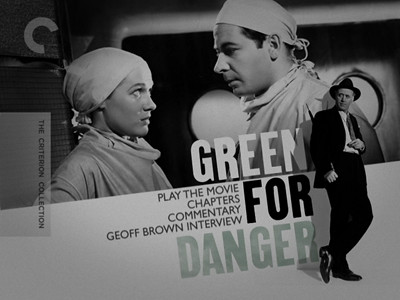
For the first quarter or so of Green for Danger, this little British war-time whodunit plays like a hospital soap opera, the direct ancestor of medical dramas like ER. Dr. Barnes (Trevor Howard) is engaged to Nurse Freddi (Sally Gray), but there is some trouble between them, and the opportunistic surgeon Mr. Eden (Leo Genn) wouldn't mind testing out his womanizing ways on the beautiful blonde. Naturally, he's blind to the affection held for him by Sister Marion Bates (Judy Campbell). Or perhaps he isn't and he's just callous to it, it's hard to tell. Eden isn't entirely bad, though, as he shows compassion to Nurse Sanson (Rosamund John), a nervous woman who hasn't been herself since her mother died from being trapped beneath the rubble of their home after a German bombing. In the midst of all this interpersonal shenanigans is Nurse Woods (Megs Jenkins), the slightly plump outsider who observes but is never really invited in.
The only thing to tip us off to the fact that Sidney Gilliat's 1946 movie is more than a love story set in a small-town hospital is the droll voiceover. Acting as a tour guide, the initially unseen narrator informs us who everyone is, and also tells us that the wounded postman (Moore Marriott) is going to die because of one of them. Only after this and a more violent death take place do we discover that our storyteller is none other than Inspector Cockrill, the hero of many of Christianna Brand's novels, including Green for Danger. Cockrill, an agent of Scotland Yard, is of the school of slightly bumbling but sharp as a whip private detectives, and he is played in Green for Danger by Alastair Sim, who would go on to play the title character in a 1951 production of Scrooge
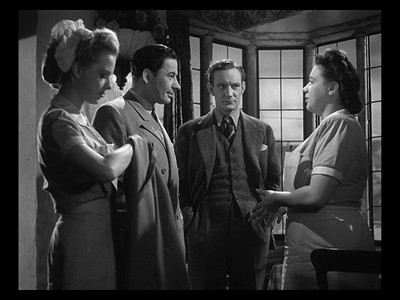
Sim's turn as Cockrill is a magnificently complete performance, full of wit and wisdom that seems to bubble up naturally from the character. Had Gilliat cast a different actor in the role, Green for Danger would be an entirely different movie. Without Sim, it's kind of a run-of-the-mill drawing room mystery, line up the pins and see which ones get bowled down. Last one standing did it! Though Gilliat honed his writing chops on Hitchcock vehicles like The Lady Vanishes, he doesn't bring anything special to Brand's story, so that on the surface of the script, it's simply a pleasant diversion. The appearance of Cockrill, however, causes it to immediately spark to life, and the fire never dims from there.
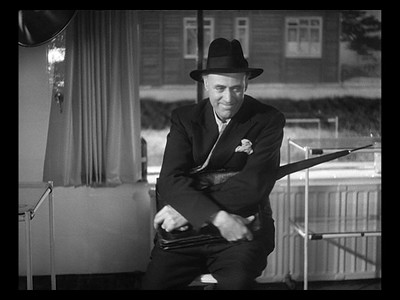
Cockrill's investigative approach is to always keep his suspects off balance. He befriends none but is kind to all, never ruling out any one possible culprit--at least not publicly. Some of his maneuvers are intended to see if he can force a revelation of what he thinks might have occurred. Sometimes, it might also just be for the fun of it. Not much is revealed, for instance, when he gets his most explosive results, goading Barnes and Eden into a fist fight, but he does see how far the two men will go and uses that to challenge them into participating in his final gambit. A detective like this follows behavior--wherever it may lead.

One thing that is interesting about Green for Danger is its staid atmosphere. There is an aura of dread floating around the edges of everything. A party thrown at the hospital may provide a momentary respite from the turmoil of WWII, but it's also a bit forced, like whistling when walking past a graveyard. Life and death are two constant states at a hospital anyway, but the ongoing threat of German bombs adds even more gray to the pallor. It's no wonder that human connections are so frayed, that Barnes and Freddi can't seem to communicate, when conversations are regularly halted by the sound of planes overhead. Worse than that noise is the silence that follows, the signal that the deadly cargo has been released.
This is another behavior that Cockrill punctures, though this time unwittingly. The man goes into a comical mini-frenzy, scurrying and stumbling about, whenever he hears the enemy approaching. This little quirk suggests his knack for deflating hubris and lies is something he comes by naturally. He is like a mechanic who peers into an engine and sees what is where it should not be. As a director, Sidney Gilliat has a similar ability to spy the proper construction of a frame, and he and director of photography Wilkie Cooper come up with quite a few astounding compositions. In particular, it's hard not to get the willies when the first obvious murder occurs, the stabbing that causes Cockrill to arrive. Gilliat shoots through glass, peering in on the scene, and whip cuts to see the killer for a moment, cranking the suspense to its most taut and dangerous. He later echoes this at the point when the identity of the murderer is revealed. These are agile moves, notable as part of a style that is assured, but not very insistent. The director is content to get most of the job done without fanfare, saving the stunning stuff for when it counts.
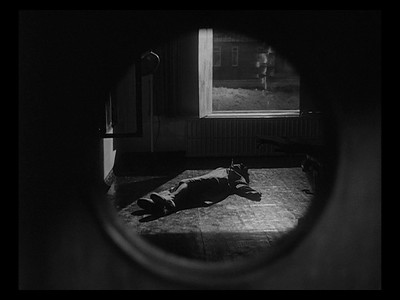
Outside of the notable Inspector, the most interesting characters are the women. They have the most personality, the more serious hidden pasts. Sister Bates has a sinister side that is quite intriguing, and Judy Campbell gives the role a creepy edge. Her self-serving menace puts me in mind of the maid in Hitchcock's Rebecca--she has been slighted and underestimated, and she will get her own back.

On the other side of things, I found Sally Gray extremely crushable as Freddi. The only other movie I have seen Gray in has been in Alberto Cavalcanti's underwhelming They Made Me a Fugitive, also co-starring Trevor Howard, and I don't really remember her from that film at all. Freddi is a likeable character, self-reliant but also vulnerable, and fitting the blonde stereotype for films like this, the one most willing to do good. Sally Gray is a lovely actress with finely sculpted features, and she has a natural grace on film. It's a pity she didn't do more of note.
With all of these positive elements swirling around, Green for Danger turns into a fairly suspenseful thriller, and the solution to the murders ends up having a few twists that make it less obvious than one would think. While Gilliat pales next to his more famous former collaborator, he clearly picked up a few tricks from Hitch, and Green for Danger could nestle quite confidently on a double-bill with any of the master's British pictures.

Beyond the movie, I think the packaging for Green for Danger is of a particularly excellent quality. I quite like Geoff Grandfield's illustrations for the cover and interior booklet. The cover is a bit of a mystery in and of itself, the solid shapes and the relationship between the colors at first looking like a random collage of eyes, but the more you look, the image comes into plain focus and you realize you are in the position of the patient on the operating table looking up at the distracted, distrustful doctors working to cure your malady. Perusing Mr. Grandfield's website, I was not all that surprised to discover that he also did some covers for editions of Graham Greene novels that I've admired in the past, including the copy of A Gun for Sale
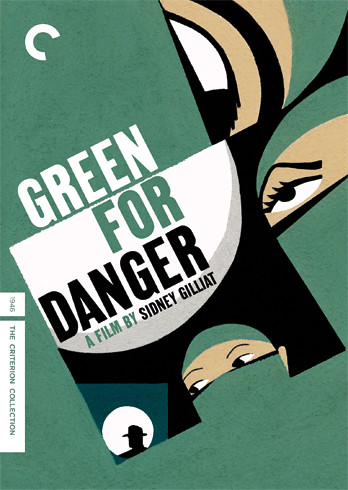
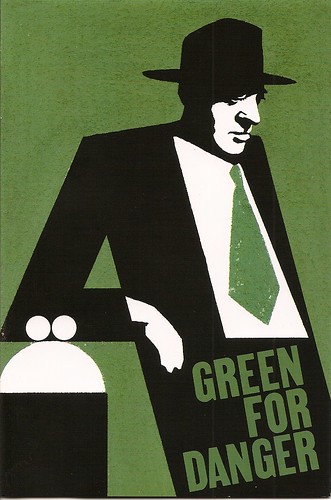

1 comment:
I just watched this last night and absolutely loved it, the ever present horror war but the impossibly light and fun murder mystery kept me smiling through that tension. Great film.
Post a Comment